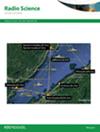Processing of VLF amplitude measurements: Deduction of a quiet time seasonal variation
IF 1.6
4区 地球科学
Q3 ASTRONOMY & ASTROPHYSICS
引用次数: 0
Abstract
The amplitude of Very Low Frequency (VLF) transmissions propagating from transmitter to receiver between the Earth's surface and the ionospheric D-region is a useful measurement to detect changes in the ionization within the D-region ranging from 60 to 90 km. The VLF signal amplitude is disturbed by geomagnetic, solar, and atmospheric phenomena. To be able to identify perturbations in the VLF signal amplitude, we determine its averaged seasonal variation under quiet solar and geomagnetic conditions. Here it is challenging, that long time series of the VLF signal amplitude show significant jumps and outliers, which are caused artificially by technical adjustments/maintenance work. This paper presents a new approach for processing long VLF data time series over multiple years resulting in level 2 data. The new level 2 data enables the consideration of time series with artificial jumps since the jumps are leveled. Moreover, the outliers are removed by a robust and systematic 2-step outlier filtering. The average seasonal and diurnal variation for different transmitter-receiver combinations can be computed with the new level 2 data by applying a composite analysis. A subsequently applied polynomial fit obtains the quiet time lines for daytime and nighttime, representing the typical seasonal variation under undisturbed conditions of the VLF signal amplitude for each considered link. The developed quiet time lines may serve as a tool to determine perturbations of the VLF signal amplitude with solar and geomagnetic as well as atmospheric origin. Also, they allow comparison of the VLF signal amplitude variation for different transmitter-receiver links.处理甚低频振幅测量:静默时间季节性变化的推导
在地球表面和电离层 D 区之间从发射器传播到接收器的甚低频(VLF)传输振幅是探测 60 至 90 千米范围内 D 区电离变化的有用测量值。甚低频信号振幅受到地磁、太阳和大气现象的干扰。为了能够识别甚低频信号振幅的扰动,我们测定了其在安静的太阳和地磁条件下的平均季节变化。在这方面具有挑战性的是,甚低频信号振幅的长时间序列会出现明显的跳跃和异常值,这是技术调整/维护工作人为造成的。本文介绍了一种处理多年来长 VLF 数据时间序列的新方法,从而生成 2 级数据。新的第 2 级数据可以考虑具有人为跳变的时间序列,因为跳变是平移的。此外,离群值是通过稳健、系统的两步离群值过滤去除的。利用新的第 2 级数据,可以通过综合分析计算出不同发射机-接收机组合的平均季节和昼夜变化。随后应用多项式拟合得到昼间和夜间的静默时间线,代表了每个考虑链路的甚低频信号振幅在不受干扰条件下的典型季节变化。所绘制的静默时间线可作为一种工具,用于确定甚低频信号振幅的太阳、地磁和大气扰动。此外,还可以对不同发射机-接收机链路的甚低频信号振幅变化进行比较。
本文章由计算机程序翻译,如有差异,请以英文原文为准。
求助全文
约1分钟内获得全文
求助全文
来源期刊

Radio Science
工程技术-地球化学与地球物理
CiteScore
3.30
自引率
12.50%
发文量
112
审稿时长
1 months
期刊介绍:
Radio Science (RDS) publishes original scientific contributions on radio-frequency electromagnetic-propagation and its applications. Contributions covering measurement, modelling, prediction and forecasting techniques pertinent to fields and waves - including antennas, signals and systems, the terrestrial and space environment and radio propagation problems in radio astronomy - are welcome. Contributions may address propagation through, interaction with, and remote sensing of structures, geophysical media, plasmas, and materials, as well as the application of radio frequency electromagnetic techniques to remote sensing of the Earth and other bodies in the solar system.
 求助内容:
求助内容: 应助结果提醒方式:
应助结果提醒方式:


